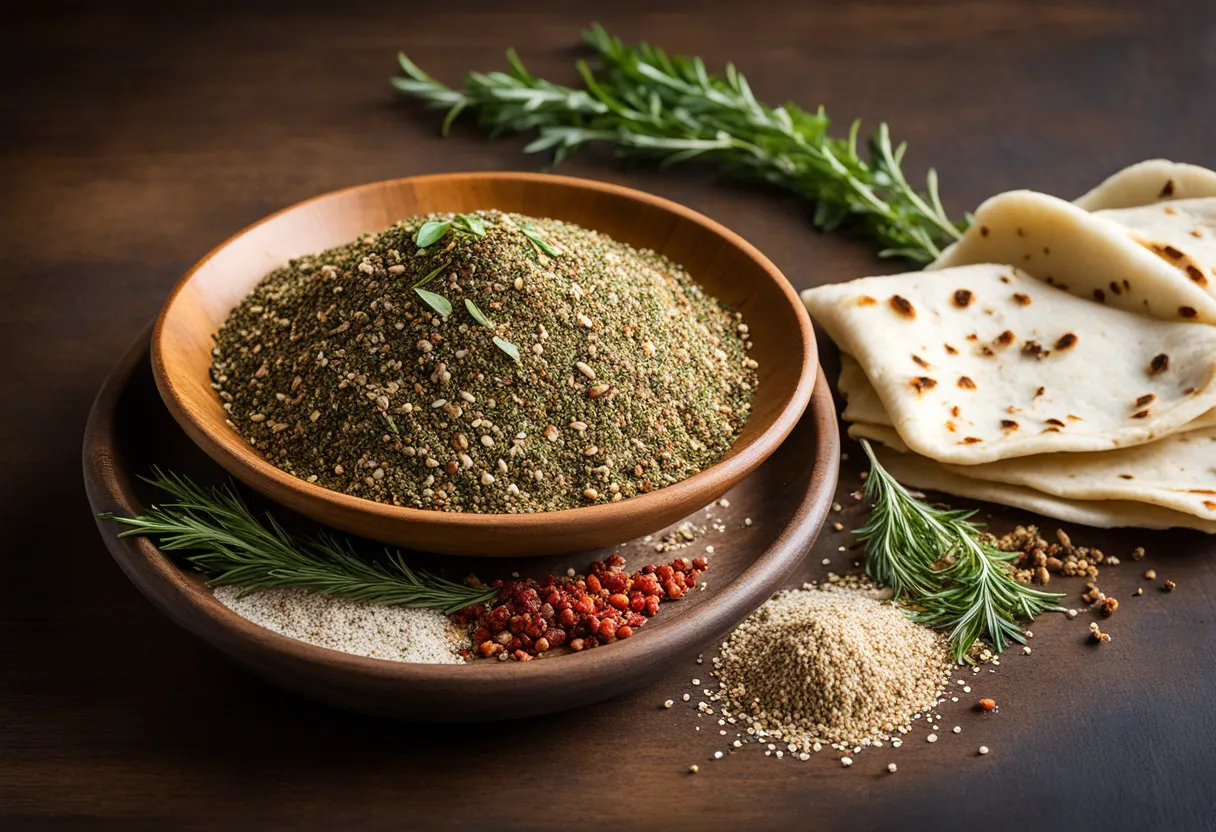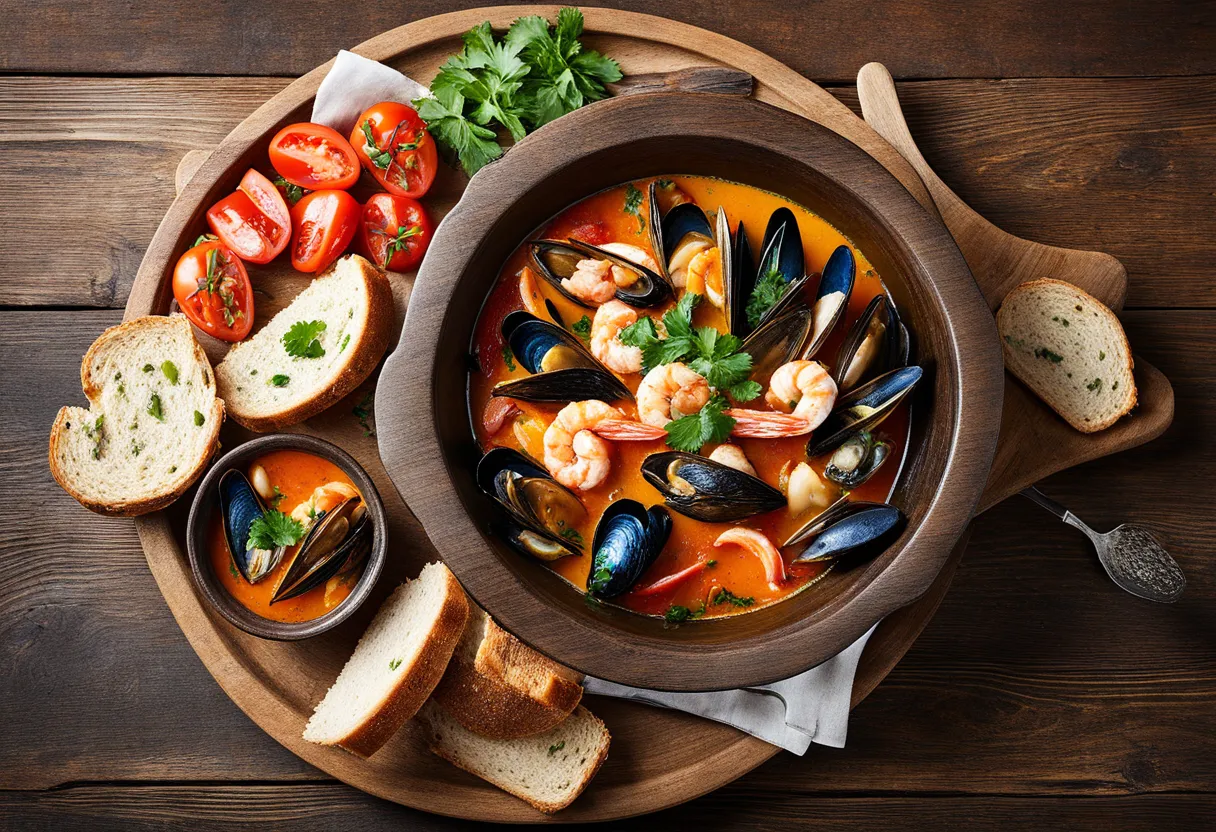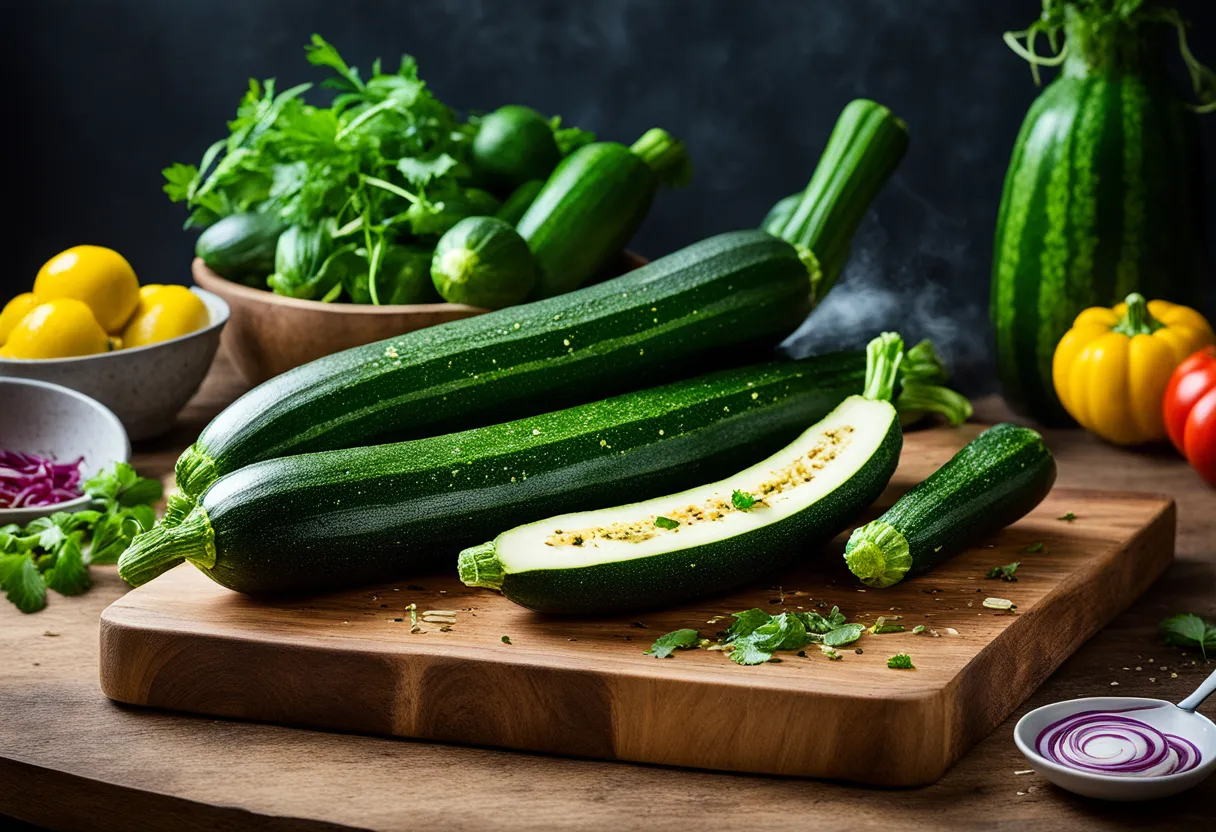Welcome to an exciting journey through the alphabet where we explore the culinary wonders that start with the letter Z. It’s a letter that might not come up often in our day-to-day vocabulary, but when it comes to food, Z packs a punch with its array of unique and flavorful dishes. From the comfort of zucchini in your favorite stir-fry to the exotic spices of za’atar that transport you to the Middle East, foods starting with Z offer a surprise and explosion of flavors that are both intriguing and delightful.
Let’s start with Zucchini, a true chameleon in the kitchen. This summer squash can sneak its way into savory dishes, adding a soft texture and a mild, slightly sweet flavor. But the surprise doesn’t end there; zucchini can also be the star in desserts, think zucchini bread or muffins, where it adds moisture and a healthful twist. The versatility of zucchini makes it a favorite among chefs and home cooks alike.
Next up, Za’atar. This Middle Eastern spice blend is a symphony of flavors, combining dried herbs like oregano and thyme, with sesame seeds, sumac, and salt. It’s the kind of seasoning that adds a vibrant kick to meats, vegetables, and bread, making every bite a delightful explosion of taste. Whether you’re sprinkling it on your roasted vegetables or incorporating it into your marinades, za’atar is sure to surprise and elevate your dishes.
For those with a sweet tooth, Zabaglione is a must-try. This Italian dessert is a light and airy custard, flavored with Marsala wine and often served over fresh fruit or as a decadent dessert sauce. The magic of zabaglione lies in its simplicity and the surprising depth of flavor that comes from just a few ingredients. It’s a perfect example of how foods starting with Z can be both simple and extraordinary.
Moving on to Zarzuela, a dish that’s like a warm hug from Spain. This seafood stew combines a variety of fish and shellfish with a rich tomato base, peppers, and spices, creating a hearty and aromatic dish that’s perfect for sharing. Zarzuela is a celebration of the sea, with each spoonful bringing a surprise of different textures and flavors, making it a memorable meal for any occasion.
Last but not least, Zwieback. This crispy, sweetened bread, twice-baked until dry and crunchy, is a simple pleasure. Often given to teething babies, zwieback is also a delightful companion to your tea or coffee, perfect for dipping. The surprise with zwieback is in its texture; what starts as a hard, dry biscuit transforms into a soft, comforting treat, proving that sometimes, the simplest foods starting with Z can be the most satisfying.
In conclusion, the world of foods starting with Z is full of surprises, from the versatility of zucchini to the complex flavors of za’atar, the delicate sweetness of zabaglione, the hearty richness of zarzuela, and the simple pleasure of zwieback. Each dish brings its own unique explosion of flavors and experiences, inviting us to explore and enjoy the culinary delights that the letter Z has to offer.
Zucchini
, often a garden’s summer bounty, is a true culinary chameleon. This versatile vegetable can sneak its way into every meal of the day, proving that it’s more than just a side dish. But what makes zucchini stand out in the vast world of produce? Let’s dive into its culinary versatility, health benefits, and some unexpected ways to enjoy it.
First off, zucchini boasts a high water content, making it low in calories but high in essential nutrients like potassium, manganese, and antioxidants. It’s a guilt-free addition to any diet, especially for those looking to add volume without the extra calories. But the magic of zucchini doesn’t stop at its nutritional profile.
When it comes to cooking, zucchini is a jack-of-all-trades. Here are just a few ways to incorporate it into your meals:
- Grilled or Roasted: A dash of olive oil, salt, and pepper can transform zucchini into a delightful side dish.
- Zoodles: Spiralized zucchini makes a fantastic low-carb substitute for pasta, pairing wonderfully with both light and hearty sauces.
- Baked Goods: Yes, zucchini can be a star in sweets! Grated zucchini adds moisture and a hint of texture to bread, muffins, and even brownies.
- Stuffed Zucchini: Hollowed-out zucchini boats filled with a mix of meats, grains, and cheeses offer a meal that’s both nutritious and satisfying.
But the surprise doesn’t end in the kitchen. Did you know zucchini flowers are edible? These delicate blossoms can be stuffed, battered, and fried for a decadent treat that’s sure to impress. It’s a perfect example of how zucchini can bring an explosion of flavor and texture to your dining table.
In conclusion, zucchini is a powerhouse of versatility, nutrition, and flavor. It’s a testament to the creativity and surprise that can be found in the world of vegetables. So, the next time you see zucchini at your local market, remember it’s not just another squash—it’s a culinary adventure waiting to happen.

Za’atar
is not just a seasoning; it’s a symphony of flavors that can transform the mundane into the extraordinary. This Middle Eastern spice blend has been a staple in culinary traditions for centuries, embodying the essence of the region’s rich flavors and aromatic heritage. The beauty of za’atar lies in its versatility and its ability to bring a unique twist to a wide range of dishes.
At its core, za’atar is a blend of dried herbs, sesame seeds, sumac, and salt. However, the exact composition can vary from one region to another, adding a beautiful complexity to this simple mixture. The dried herbs typically include thyme, oregano, or marjoram, each adding their distinct notes to the blend. Sumac, with its tangy and slightly fruity flavor, cuts through the earthiness of the herbs, while sesame seeds offer a subtle crunch and nuttiness.
How can you use za’atar, you ask? Let me count the ways:
- Meats: Rub za’atar on chicken, beef, or lamb before grilling or roasting to infuse them with its distinctive flavors.
- Vegetables: Sprinkle it over roasted or grilled vegetables for an instant flavor boost.
- Breads: Mix za’atar with olive oil and spread it on bread before baking or use it as a dip for fresh bread.
- Yogurt: Stir it into Greek yogurt to create a savory dip or sauce.
The explosion of taste that za’atar brings to the table is nothing short of a culinary surprise. It’s a testament to the power of simple ingredients coming together to create something truly magnificent. So, the next time you’re looking to spice up your cooking, remember za’atar. It’s not just a spice blend; it’s a journey through the flavors of the Middle East.
Zabaglione
Imagine the perfect end to a sumptuous Italian feast, and you’ll likely conjure up an image of . This decadent dessert is a symphony of simple ingredients whipped into a light, foamy custard that dances on the tongue with its rich Marsala wine flavor. But don’t be fooled by its luxurious taste and texture; Zabaglione is surprisingly easy to make, requiring just a handful of ingredients and a bit of whisking magic.
At its core, Zabaglione is a testament to the Italian culinary philosophy of using high-quality ingredients to create something truly extraordinary. The key players in this dessert are egg yolks, sugar, and Marsala wine – each bringing its own unique contribution to the table. The egg yolks provide a silky base, the sugar adds sweetness, and the Marsala wine infuses the custard with a depth of flavor that is simply irresistible.
Here’s a quick rundown of what you’ll need to whip up your own Zabaglione:
- Egg yolks: The foundation of the custard, offering richness and color.
- Sugar: To sweeten the deal.
- Marsala wine: This Sicilian wine is the secret to Zabaglione’s distinctive taste. If Marsala isn’t available, you can substitute it with another sweet wine or even a dry sherry.
Preparing Zabaglione is akin to conducting a culinary orchestra. You’ll whisk the egg yolks and sugar until they’re pale and thick, then gradually incorporate the Marsala wine. The mixture is then gently cooked over a double boiler, whisking continuously, until it becomes a frothy, creamy delight. The result? A warm, comforting custard that’s both light and satisfying.
Zabaglione can be enjoyed in a variety of ways, whether it’s served simply in a glass, accompanied by fresh fruit, or used as an elegant sauce to elevate other desserts. It’s a versatile finale to any meal, capable of adapting to the seasons and your personal taste preferences. So, why not embrace the art of Italian dessert-making and surprise your guests with a bowl of homemade Zabaglione? It’s sure to be a culinary explosion that leaves everyone asking for more.

Zarzuela
Imagine diving into a culinary treasure chest of the sea, and you’ve got – a symphony of seafood that sings the song of Spanish coastlines. This dish is not just food; it’s an experience, a celebration of the ocean’s bounty. Zarzuela is a rich, aromatic seafood stew that masterfully combines a variety of fish and shellfish, making it a must-try for any seafood lover.
Zarzuela’s charm lies in its versatility. From the choice of seafood to the aromatic blend of tomatoes, peppers, and spices, each ingredient plays a crucial role in creating its unique flavor profile. Here’s a simple breakdown of what goes into making this delightful dish:
- Seafood: The stars of the show. Typically includes a mix of shrimp, mussels, clams, and firm-fleshed fish. Feel free to add squid or lobster for an extra touch of luxury.
- Tomatoes and Peppers: These add a sweet and tangy flavor that complements the seafood perfectly.
- Garlic and Onions: For that aromatic base that no Spanish dish can do without.
- Spices: A pinch of saffron and paprika not only adds color but an incredible depth of flavor.
What sets Zarzuela apart is not just the sumptuous combination of ingredients but the way it’s served. Gathered around the table, friends and family dive into a communal pot, sharing stories and laughter, making Zarzuela more than just a meal – it’s an occasion.
So, next time you’re looking to impress your dinner guests or indulge in a seafood feast, remember Zarzuela. It’s not just a dish; it’s a journey to the heart of Spanish cuisine, a delightful explosion of flavors that promises to surprise and satisfy your palate.
Zwieback
, which literally translates to “twice baked” in German, is a delight that crosses the boundaries of age, serving as a comforting snack from infancy through adulthood. Its origin story is as rich and layered as its texture. Initially created to preserve bread, zwieback has evolved into a beloved snack enjoyed around the globe. Its crispy, sweet nature makes it a versatile treat, perfect for a variety of occasions.
Why do people of all ages enjoy zwieback so much? Let’s break it down:
- Texture: The dual baking process results in a unique, crunchy texture that’s not just satisfying to bite into but also gentle enough for teething babies.
- Flavor: Lightly sweetened, zwieback offers a subtle taste that pairs wonderfully with both sweet and savory accompaniments, such as tea, coffee, or cheese.
- Versatility: Whether you’re using it as a base for a decadent dessert or simply dunking it in your morning coffee, zwieback’s simplicity is its strength, offering endless culinary possibilities.
Here’s a fun fact to chew on: in some cultures, zwieback is more than just a snack; it’s a part of tradition. For instance, in Germany, it’s common to serve zwieback to guests as a symbol of hospitality. This crispy bread has a way of bringing people together, making it a staple in pantries around the world.
So, next time you reach for a piece of zwieback, remember you’re not just enjoying a simple snack. You’re indulging in a piece of culinary history that has brought comfort and joy to countless generations. Whether enjoyed plain, dipped, or as part of a more elaborate dish, zwieback continues to surprise and delight with its explosion of simplicity and flavor.





